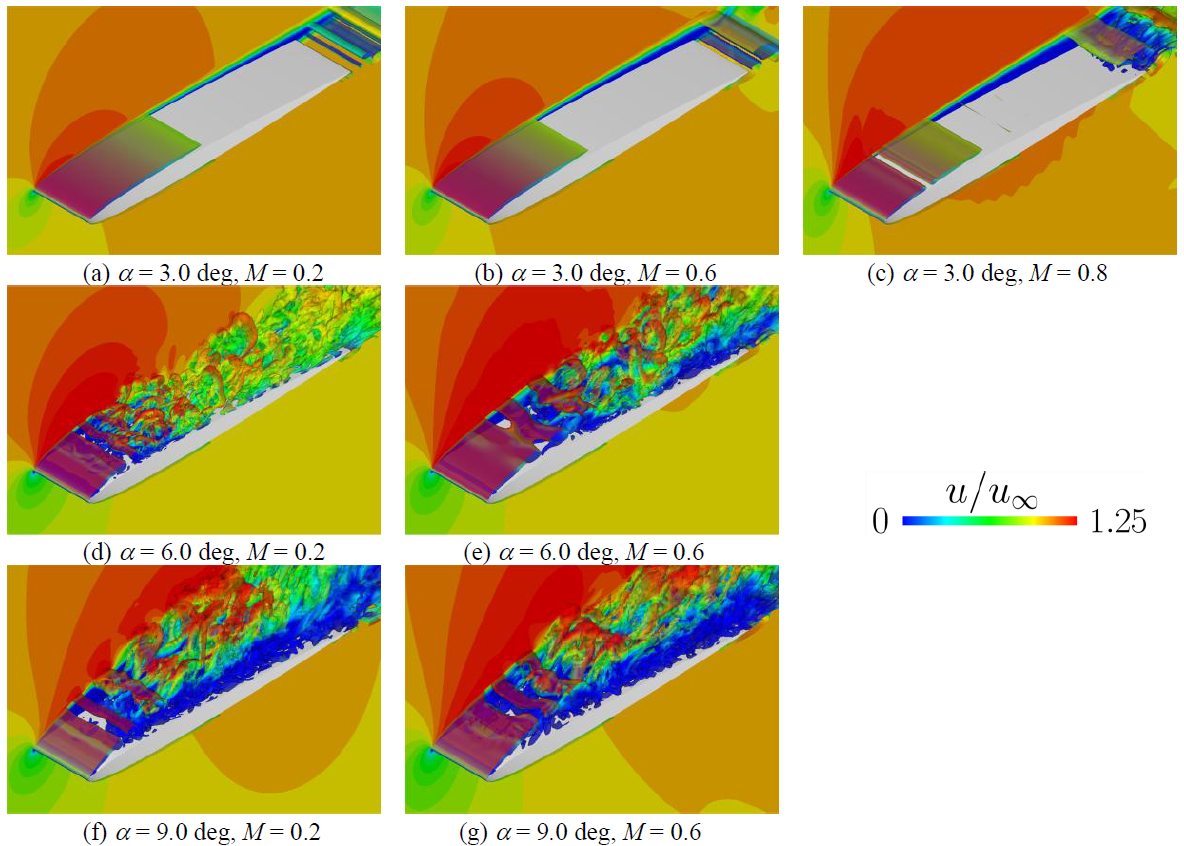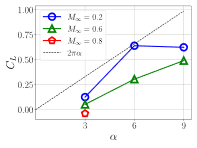Wall-resolved LES for low Reynolds number compressible flows around a symmetric airfoil
JAXA Supercomputer System Annual Report February 2024-January 2025
Report Number: R24EACA49
Subject Category: JSS Inter-University Research
- Responsible Representative: Taku Nonomura, Professor, Nagoya University
- Contact Information: Taku Nonomura (Professor at Nagoya University)(nonomura@nagoya-u.jp)
- Members: Taku Nonomura, Takayuki Nagata
Abstract
Large-eddy simulations (LES) are performed under compressible conditions of flow around symmetric airfoils, including flat plates with Reynolds numbers of O(10^3)-O(10^4), to elucidate the effects of compressibility on laminar separation bubbles and turbulent transition. In the low Reynolds number region investigated in this study, important phenomena for low Reynolds number aerodynamics are pronounced, such as the formation of laminar separation bubbles and turbulent transition. By precisely investigating the effects of compressibility on these phenomena, knowledge will be gained that will contribute to improving the performance of fluid machinery operated under high-speed and low-pressure conditions, such as the Mars aircraft.
Reference URL
N/A
Reasons and benefits of using JAXA Supercomputer System
In the present study, a parametric study by large-eddy simulations is conducted, and thus, a large-scale parallel calculation is required.
Achievements of the Year
We performed the DNS around NACA0006 and NACA0012 airfoils at a Reynolds number of 2.3 x 10^4 and investigated the effect of Mach number, the airfoil thickness, and the angle of attack on the flow field and the aerodynamic characteristics. For the higher Mach number, the formation position of the vortex structure and the separation point are located closer to the leading edge at the condition of AoA = 3.0 deg. However, they are located closer to the trailing edge for AoA = 6.0 deg and AoA = 9.0 deg for higher Mach numbers. In addition, the size of the vortex structure increases due to the increase in Mach number (figs. 1 and 2). For all airfoils investigated, the lift coefficient decreases with increasing Mach number, but performance is relatively maintained for thiner airfoils (figs. 3 and 4).

Fig.1: Instantaneous velocity fields and vortical structure of flow around NACA0012 airfoil visualized by the second invariant of the velocity gradient tensor (perspective view). The threshold of the isosurface is Q/u_inf^2 = 5.

Fig.2: Instantaneous velocity fields and vortical structure of flow around NACA0006 airfoil visualized by the second invariant of the velocity gradient tensor (perspective view). The threshold of the isosurface is Q/u_inf^2 = 5.
Publications
N/A
Usage of JSS
Computational Information
- Process Parallelization Methods: MPI
- Thread Parallelization Methods: OpenMP
- Number of Processes: 44
- Elapsed Time per Case: 150 Hour(s)
JSS3 Resources Used
Fraction of Usage in Total Resources*1(%): 0.04
Details
Please refer to System Configuration of JSS3 for the system configuration and major specifications of JSS3.
| System Name | CPU Resources Used(Core x Hours) | Fraction of Usage*2(%) |
|---|---|---|
| TOKI-SORA | 624174.20 | 0.03 |
| TOKI-ST | 0.00 | 0.00 |
| TOKI-GP | 0.00 | 0.00 |
| TOKI-XM | 0.00 | 0.00 |
| TOKI-LM | 0.00 | 0.00 |
| TOKI-TST | 0.00 | 0.00 |
| TOKI-TGP | 0.00 | 0.00 |
| TOKI-TLM | 0.00 | 0.00 |
| File System Name | Storage Assigned(GiB) | Fraction of Usage*2(%) |
|---|---|---|
| /home | 54.45 | 0.04 |
| /data and /data2 | 111926.22 | 0.54 |
| /ssd | 0.00 | 0.00 |
| Archiver Name | Storage Used(TiB) | Fraction of Usage*2(%) |
|---|---|---|
| J-SPACE | 17.95 | 0.06 |
*1: Fraction of Usage in Total Resources: Weighted average of three resource types (Computing, File System, and Archiver).
*2: Fraction of Usage:Percentage of usage relative to each resource used in one year.
ISV Software Licenses Used
| ISV Software Licenses Used(Hours) | Fraction of Usage*2(%) | |
|---|---|---|
| ISV Software Licenses(Total) | 0.00 | 0.00 |
*2: Fraction of Usage:Percentage of usage relative to each resource used in one year.
JAXA Supercomputer System Annual Report February 2024-January 2025




